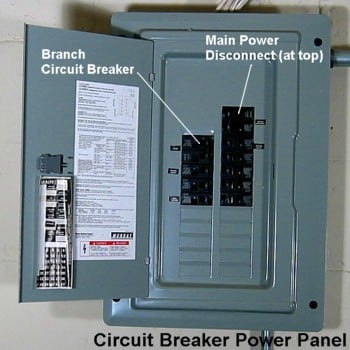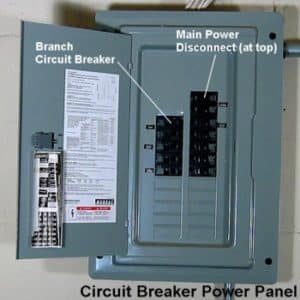As a homeowner, you need access to the panel for three tasks:
• To shut off power to the whole house if needed (you do this by switching off the large breaker)
• To reset a circuit breaker that trips.
• To turn off power to individual circuits when you are doing electrical work somewhere in the house.
Why Do Circuit Breakers Trip?
If you plug too many appliances into a circuit, the system senses that they require more power than the circuit can accommodate and the circuit breaker trips, shutting off power completely. It’s a safety measure designed to protect the wiring in the circuit, as too great a demand can cause the wires to overheat.
Each circuit has a limit of how much power it can handle. You will find that limit printed on each breaker. The number represents the amps, which measure the rate or quantity of electrical flow.
Stopping Circuit Breakers from Tripping
Reducing demand on the circuit is the best way to prevent breakers from tripping. Appliances list their energy demands on an identification label on the unit. Most services experience tripping when juggling power demands. For example, if the breaker trips when you use the microwave and the toaster oven at the same time, you will have to move one of those appliances to another circuit.
Reset a breaker in the service panel by first pushing it to the “OFF” position and then pushing it back to the “ON” position. Fuses in older panels can’t be reset but must be replaced. Always replace a fuse with another of the same amperage. Don’t be tempted to install a higher-amp fuse because wiring size corresponds to amps. Wiring that is too small for the new fuse could overheat.
Map the Circuits
Make sure that the inside of the panel door has a legend that clearly indicates which rooms and/or appliances are powered by which breakers. Many service panels’ legends are missing, illegible or inaccurate. Make sure that yours is up to date. Work with a helper and methodically go through the house testing the circuits. Don’t assume that all of the outlets in a room are on one circuit.
Be Responsible and Safe!
Unless a breaker trips or you want to shut off power to do some electrical work, there’s no need to deal with your service panel. But it’s important to know where it’s located and to keep the area around it clear so that it’s accessible in an emergency. It’s also a good idea to store a working flashlight nearby in the event of a power outage.
If the door to your home’s electrical service panel has scorch marks, that could indicate dangerous arcing. If it’s rusted, there may be water infiltration. It’s best to call a licensed electrician to investigate such issues further.
If your home’s electrical service uses fuses, be sure to keep compatible replacements available.


